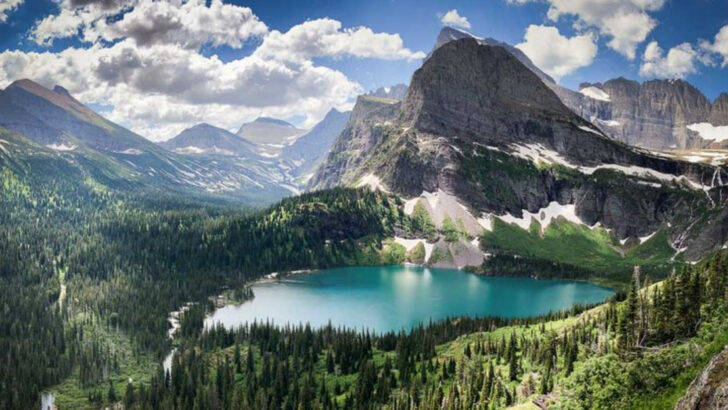Nature isn’t waiting for permission — it’s moving back in. Cracked sidewalks are now crawling with wildflowers. Abandoned buildings echo with birdsong. And once-bustling towns are being quietly reclaimed by forests, sand, and mossy silence. But here’s the twist: tourists love it. From sunken gardens blooming in old quarries to ghost towns wrapped in ivy and mystery, these 14 U.S. spots prove that when nature takes over, it doesn’t destroy — it transforms. The result? Places that feel raw, haunting, and wildly beautiful in ways no theme park could ever replicate. You won’t find souvenir shops on every corner. But you will find magic.
Great Smoky Mountains, Tennessee/North Carolina
The Great Smoky Mountains are a testament to nature’s untamed beauty. Straddling the border between Tennessee and North Carolina, these mountains are renowned for their diverse ecosystems and mist-covered peaks. Visitors can explore ancient forests, cascading waterfalls, and a rich variety of wildlife.
The park is a haven for hikers and nature enthusiasts. With over 800 miles of trails, there’s something for everyone, from gentle walks to challenging treks. The Smokies are especially popular in autumn, when the foliage transforms into a vibrant sea of reds, oranges, and yellows.
Did you know? The park is home to over 1,500 black bears.
Yosemite National Park, California
Yosemite National Park is a crown jewel of the American wilderness. Known for its towering granite cliffs, cascading waterfalls, and ancient giant sequoias, Yosemite draws nature lovers, climbers, and photographers from around the world.
The park’s iconic landmarks, like El Capitan and Half Dome, offer breathtaking views and challenging climbs. The serene Yosemite Valley provides a tranquil retreat for those seeking solace in nature. Each season brings its own charm, from the blooming wildflowers of spring to the snowy landscapes of winter.
Fun fact: Yosemite was central to the development of the national park system.
Yellowstone National Park, Wyoming/Montana/Idaho
Yellowstone National Park is a natural wonderland, renowned for its geothermal features and diverse wildlife. Spanning three states, it’s home to the famous Old Faithful geyser, colorful hot springs, and a myriad of wildlife including bison, wolves, and grizzly bears.
Visitors can explore a range of landscapes, from lush meadows to dramatic canyons and rugged mountains. The park offers numerous opportunities for hiking, camping, and wildlife spotting, providing a perfect escape into the wild.
Did you know? Yellowstone was the first national park in the world, established in 1872.
Acadia National Park, Maine
Acadia National Park on Mount Desert Island is a coastal gem where rugged cliffs meet the Atlantic Ocean. Known for its stunning sunrises from Cadillac Mountain, it’s a paradise for photographers and outdoor enthusiasts.
The park offers a variety of activities, including hiking, biking, and bird watching. Visitors can explore diverse ecosystems, from rocky shores to dense forests and tranquil lakes. In autumn, the park’s foliage displays a spectacular array of colors.
Fun fact: Acadia is one of the first places in the U.S. to see the sunrise each day.
Zion National Park, Utah
Zion National Park is known for its awe-inspiring red rock formations and deep canyons. The park’s unique landscapes attract adventurers and nature lovers alike, offering opportunities for hiking, climbing, and photography.
The famous Zion Canyon, carved by the Virgin River, provides breathtaking views and challenging hikes like Angels Landing. The park is a sanctuary for diverse plant and animal species, thriving in the desert environment.
Did you know? Zion is home to over 1,000 plant species, adapting to its varied climates and elevations.
Olympic National Park, Washington
Olympic National Park is a land of contrasts, encompassing diverse ecosystems from rugged coastlines to lush rainforests and alpine peaks. This World Heritage Site offers a unique blend of natural beauty and biodiversity.
Visitors can explore the park’s three distinct ecosystems: the Pacific coastline, the temperate rainforest, and the mountainous interior. Each area offers its own set of activities and experiences, from beachcombing to high-altitude hiking.
Fun fact: The park is home to the largest expanse of temperate rainforest in the contiguous U.S.
Glacier National Park, Montana
Glacier National Park is a haven for nature-lovers and adventurers. Known for its breathtaking landscapes, it features over 700 miles of hiking trails, glacial-carved valleys, and clear alpine lakes.
Visitors can explore the famous Going-to-the-Sun Road, offering panoramic views of the park’s stunning scenery. The park is a sanctuary for diverse wildlife, including mountain goats and grizzly bears.
Did you know? Glacier National Park is part of the world’s first International Peace Park, shared with Canada’s Waterton Lakes National Park.
Everglades National Park, Florida
The Everglades National Park is a unique subtropical wilderness, offering a habitat for a wide array of wildlife including alligators, manatees, and the elusive Florida panther. It’s a sanctuary of wetlands and mangroves.
Visitors can explore the park’s waterways by kayak or airboat, providing a close-up look at its rich biodiversity. The Everglades also offers hiking trails and bird-watching opportunities.
Fun fact: The Everglades is the only place in the world where alligators and crocodiles coexist.
Grand Canyon National Park, Arizona
The Grand Canyon is a natural wonder that leaves visitors in awe. This immense canyon, carved by the Colorado River, offers breathtaking views and a rich geological history.
Hikers can explore the canyon’s trails, ranging from short walks to challenging backcountry treks. The park also provides opportunities for rafting and helicopter tours, offering unique perspectives of its grandeur.
Did you know? The Grand Canyon reveals nearly two billion years of Earth’s geological history.
Denali National Park, Alaska
Denali National Park is a place of majestic beauty, home to North America’s tallest peak, Mount Denali. This vast wilderness offers stunning landscapes and abundant wildlife, including caribou and grizzly bears.
Visitors can embark on guided tours, hiking, and wildlife viewing, immersing themselves in the park’s pristine environment. The park’s remoteness and size make it a haven for those seeking solitude and adventure.
Fun fact: Denali’s name means “The Great One” in the native Athabascan language.
Joshua Tree National Park, California
Joshua Tree National Park is a captivating desert landscape where two distinct ecosystems, the Mojave and Colorado deserts, converge. Known for its unique Joshua trees and striking rock formations, it’s a playground for climbers and stargazers.
The park offers a variety of trails and viewpoints, perfect for exploring its surreal beauty. The clear desert skies make it an ideal spot for stargazing, with night skies revealing a dazzling array of stars.
Did you know? The park’s namesake, the Joshua tree, is not actually a tree but a species of yucca.
Rocky Mountain National Park, Colorado
Rocky Mountain National Park showcases the breathtaking beauty of alpine environments. With its towering peaks, pristine lakes, and abundant wildlife, it’s a must-visit for nature enthusiasts.
The park offers a range of recreational activities, from hiking and camping to wildlife viewing and scenic drives along Trail Ridge Road. Its diverse ecosystems support an array of flora and fauna, including elk and bighorn sheep.
Fun fact: The park is home to Longs Peak, one of Colorado’s famous “Fourteeners.”
Arches National Park, Utah
Arches National Park is renowned for its striking natural arch formations, sculpted by wind and water over millions of years. The park’s unique geology attracts photographers and adventurers alike.
Visitors can explore a landscape filled with over 2,000 natural stone arches, including the iconic Delicate Arch. The park offers hiking trails and viewpoints, providing awe-inspiring vistas of its surreal rock landscapes.
Did you know? The park’s name comes from the staggering number of natural stone arches within its boundaries.
Shenandoah National Park, Virginia
Shenandoah National Park is a treasure of the Appalachian Mountains, offering rolling hills, lush forests, and abundant wildlife. It’s a sanctuary for those seeking peace and tranquility.
The park is traversed by the famous Skyline Drive, offering panoramic views of the Shenandoah Valley. Visitors can hike sections of the Appalachian Trail, explore waterfalls, and enjoy the vibrant colors of fall foliage.
Fun fact: Over 40% of the park’s area is designated as wilderness, providing a haven for wildlife and a refuge for visitors.

